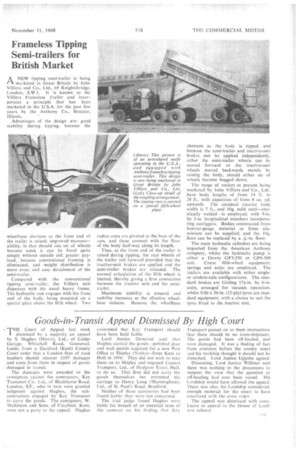Frameless Tipping Semi-trailers for British Market
Page 71

If you've noticed an error in this article please click here to report it so we can fix it.
A NEW tipping semi-trailer is being in, marketed in Great Britain by John Villiers and Co., Ltd., 69 Knightsbridge, London, S.W.I. It is known as the Villiers Frameless Trailer and incorporates a principle that has been marketed in the U.S.A. for the past five years by the Anthony Co., Streator,
Advantages of the design are: good stability during tipping, because the wheelbase shortens as the front end of the trailer is raised; improved manoeuvrability, in that should one set of wheels become stuck it can be freed quite simply without outside aid; greater payload, . because conventional framing is eliminated, and weight distribution is more even; and easy detachment of the semi-trailer.
Compared with the conventional tipping semi-trailer, the Villiers unit dispenses with the usual heavy frame. The hydraulic ram engages with the front end of the body, being mounted on a special plate above the fifth wheel. Two
radius arms are pivoted at the base of the ram, and these connect with the floor of the body half-way along its length.
Thus, as the front end of the trailer is raised during tipping, the rear wheels of the trailer roll forward provided that the tractive-unit brakes are applied and the semi-trailer brakes arc released. The normal articulation of the fifth wheel is limited, .thereby giving a firm connection between the tractive unit and the semitrailer.
Maximum stability is assured and stability increases as the effective wheelbase reduces. Because the wheelbase shortens as the body is tipped, and because the semi-trailer and tractive-unit brakes can be applied independently, either the semi-trailer wheels can be moved forward or the tractive-unit wheels moved backwards merely by raising the body, should either set of wheels become bogged down,
The range of trailers at present being marketed by John Villiers and Co„ Ltd., have body lengths of from 14 ft. to 24 ft., with capacities of from 8 cu. yd. upwards. The standard interior body width is 7 ft., and 10g, mild steel—electrically .welded--is employed, with 9-in. by 3-in, longitudinal members incorporating outriggers. Bodies constructed from heavier-gauge material or from aluminium can be supplied, and the 10g. floor can be replaced by a 13,e-in. floor.
The main hydraulic cylinders are being imported from the American Anthony company, whilst the hydraulic pump is either a Dowty GP3-250 or GP4-300 unit. Crane fifth-wheel equipment, springs and axles are employed. The trailers are available with 'either singleor tandem-axle configuration& The standard brakes are Girling 151-in. by 6-in. units, arranged for vacuum operation, whilst 9.00 x 20-in. (12-ply) tyres are standard equipment, with a choice to suit the tyres fitted to the tractive unit.
















































































































































